Drought Dynamics and Drought Hazard Assessment in Southwest Bulgaria
Abstract
:1. Introduction
2. Materials and Methods
2.1. Study Area
2.2. Data and Methods
3. Results and Discussion
Drought Occurrence and Frequency
4. Conclusions
Author Contributions
Funding
Institutional Review Board Statement
Informed Consent Statement
Data Availability Statement
Acknowledgments
Conflicts of Interest
References
- Brás, A.; Seixas, J.; Carvalhais, N.; Jägermeyr, J. Severity of drought and heatwave crop losses tripled over the last five decades in Europe. Environ. Res. Lett. 2021, 16, 065012. [Google Scholar] [CrossRef]
- Ciais, P.; Reichstein, M.; Viovy, N.; Granier, A.; Ogée, J.; Allard, V.; Aubinet, M.; Buchmann, N.; Bernhofer, C.; Carrara, A.; et al. Europe-wide reduction in primary productivity caused by the heat and drought in 2003. Nature 2005, 437, 529–533. [Google Scholar] [CrossRef] [PubMed]
- FAO. Drought emergency. Emergency Ministerial-Level Meeting. Summary of the Co-Chairs; FAO: Rome, Italy, 2011. [Google Scholar]
- Grayson, M. Agriculture and drought. Nature 2013, 501, S1. [Google Scholar] [CrossRef] [PubMed]
- Tripathy, P.; Mishra, A. How unusual is the 2022 European compound drought and heatwave event? Geophys. Res. Lett. 2023, 50, e2023GL105453. [Google Scholar] [CrossRef]
- IPCC: Climate Change 2021: The Physical Science Basis. Contribution of Working Group I to the Sixth Assessment Report of the Intergovernmental Panel on Climate Change; IPCC 2021: Geneva, Switzerland. [CrossRef]
- Trenberth, K.; Dai, A.; van der Schrier, G.; Jones, P.D.; Barichivich, J.; Briffa, K.R.; Sheffield, J. Global warming and changes in drought. Nat. Clim. Change 2014, 4, 17–22. [Google Scholar] [CrossRef]
- Vicente-Serrano, S.M.; Beguería, S.; López-Moreno, J.I. A multiscalar drought index sensitive to global warming: The standardized precipitation evapotranspiration index. J. Clim. 2010, 23, 1696–1718. [Google Scholar] [CrossRef]
- AghaKouchak, A.; Feldman, D.; Hoerling, M.; Huxman, T.; Lund, J. Water and climate: Recognize anthropogenic drought. Nature 2015, 524, 409–411. [Google Scholar] [CrossRef]
- Diffenbaugh, N.S.; Swain, D.L.; Touma, D. Anthropogenic warming has increased drought risk in California. Proc. Natl. Acad. Sci. USA 2015, 112, 3931–3936. [Google Scholar] [CrossRef]
- Lesk, C.; Rowhani, P.; Ramankutty, N. Influence of extreme weather disasters on global crop production. Nature 2016, 529, 84–87. [Google Scholar] [CrossRef] [PubMed]
- Niggli, L.; Huggel, C.; Muccione, V.; Neukom, R.; Salzmann, N. Towards improved understanding of cascading and interconnected risks from concurrent weather extremes: Analysis of historical heat and drought extreme events. PLoS Clim. 2022, 1, e0000057. [Google Scholar] [CrossRef]
- Chen, H.; Sun, J. Changes in drought characteristics over China using the standardized precipitation evapotranspiration index. J. Clim. 2015, 28, 5430–5447. [Google Scholar] [CrossRef]
- Van Loon, A.F.; Gleeson, T.; Clark, J.; Van Dijk, A.I.J.M.; Stahl, K.; Hannaford, J.; Di Baldassarre, G.; Teuling, A.J.; Tallaksen, L.M.; Uijlenhoet, R.; et al. Drought in the Anthropocene. Nat. Geosci. 2016, 9, 89–91. [Google Scholar] [CrossRef]
- Bruins, H.J.; Berliner, P. Bioclimatic aridity, climatic variability, drought and desertification: Definitions and management options. Geo J. Libr. 1998, 41, 97–116. [Google Scholar] [CrossRef]
- Field, J.A.; Breshears, D.D.; Bradford, J.B.; Law, D.J.; Feng, X. Forest management under megadrought: Urgent needs at finer scale and higher intensity. Front. For. Glob. Change 2020, 3, 502669. [Google Scholar] [CrossRef]
- MacDonald, G.M. Severe and sustained drought in southern California and the West: Present conditions and insights from the past on causes and impacts. Quat. Int. 2007, 173–174, 87–100. [Google Scholar] [CrossRef]
- Quiring, S.M.; Papakryiakou, T.N. An evaluation of agricultural drought indices for the Canadian prairies. Agric. For. Meteorol. 2003, 118, 49–62. [Google Scholar] [CrossRef]
- Beran, M.A.; Rodier, J.A. Hydrological Aspects of Drought: A Contribution to the International Hydrological Programme, (Studies and Reports in Hydrology IHP; UNESCO: Paris, France, 1985. [Google Scholar]
- Hisdal, H.; Stahl, K.; Tallaksen, L.M.; Demuth, S. Have streamflow droughts in Europe become more severe or frequent? Int. J. Climatol. 2001, 21, 317–333. [Google Scholar] [CrossRef]
- Tallaksen, L.M.; Van Lanen, H.A.J. Hydrological Drought, Processes and Estimation Methods for Streamflow and Groundwater, Developments in Water Sciences; Elsevier: Amsterdam, The Netherlands, 2004; p. 48. [Google Scholar]
- UNDRR. Global Assessment Report on Disaster Risk Reduction; United Nations Office for Disaster Risk Reduction (UNDRR): Geneva, Switzerland, 2019. [Google Scholar]
- Stahl, K.; Hisdal, H.; Hannaford, J.; Tallaksen, L.M.; Lanen, H.; Sauquet, É.; Sauquet, E.; Demuth, S.; Fendekova, M.; Jódar, J. Streamflow trends in Europe: Evidence from a dataset of near-natural catchments. Hydrol. Earth Syst. Sci. 2010, 14, 2367–2382. [Google Scholar] [CrossRef]
- Sheffield, J.; Wood, E.F. Global Trends and Variability in Soil Moisture and Drought Characteristics, 1950–2000, from Observation-Driven Simulations of the Terrestrial Hydrologic Cycle. J. Clim. 2008, 21, 432–458. [Google Scholar] [CrossRef]
- Haile, G.G.; Tang, Q.; Sun, S.; Huang, Z.; Zhang, X.; Liu, X. Droughts in East Africa: Causes, impacts and resilience. Earth-Sci. Rev. 2019, 193, 146–161. [Google Scholar] [CrossRef]
- Rebetez, M.; Mayer, H.; Dupont, O.; Schindler, D.; Gartner, K.; Kropp, J.; Menzel, A. Heat and drought 2003 in Europe: A climate synthesis. Ann. For. Sci. 2006, 63, 569–577. [Google Scholar] [CrossRef]
- Salimi, H.; Asadi, E.; Darbandi, S. Meteorological and hydrological drought monitoring using several drought indices. Appl. Water Sci. 2021, 11, 11. [Google Scholar] [CrossRef]
- Laaha, G.; Parajka, J.; Viglione, A.; Koffler, D.; Haslinger, K.; Schöner, W.; Zehetgruber, J.; Blöschl, G. A three-pillar approach to assessing climate impacts on low flows. Hydrol. Earth Syst. Sci. 2016, 20, 3967–3985. [Google Scholar] [CrossRef]
- Tsakiris, G.; Nalbantis, I.; Vangelis, H.; Verbeiren, B.; Huysmans, M.; Tychon, B.; Jacquemin, I.; Canters, F.; Vanderhaegen, S.; Engelen, G.; et al. A system-based paradigm of drought analysis for operational management. Water Resour. Manag. 2013, 27, 5281–5297. [Google Scholar] [CrossRef]
- Beniston, M. The 2003 Heat Wave in Europe: A Shape of Things to Come? An Analysis Based on Swiss Climatological Data and Model Simulations. Geophys. Res. Lett. 2004, 31, L02202. [Google Scholar] [CrossRef]
- Barriopedro, D.; Fischer, E.M.; Luterbacher, J.; Trigo, R.M.; García-Herrera, R. The Hot Summer of 2010: Redrawing the Temperature Record Map of Europe. Science 2010, 332, 220–224. [Google Scholar] [CrossRef] [PubMed]
- Baruth, B.; Bassu, S.; Bussay, A.; Ceglar, A.; Cerrani, I.; Chemin, Y.; De Palma, P.; Fumagalli, D.; Lecerf, R.; Manfron, G.; et al. Crop Monitoring in Europe, JRC MARS Bulletin; Publications Office of the European Union: Luxembourg, 2020; Volume 28, p. JRC120746. [Google Scholar]
- Boergens, E.; Güntner, A.; Dobslaw, H.; Dahle, C. Quantifying the Central European Droughts in 2018 and 2019 with 512 GRACE Follow-On. Geophys. Res. Lett. 2020, 47, e2020GL087285. [Google Scholar] [CrossRef]
- Liu, Z.; Li, C.; Zhou, P.; Chen, X. A probabilistic assessment of the likelihood of vegetation drought under varying climate conditions across China. Sci. Rep. 2016, 6, 3510. [Google Scholar] [CrossRef] [PubMed]
- Ionita, M.; Tallaksen, L.M.; Kingston, D.G.; Stagge, J.H.; Laaha, G.; Lanen, H.A.J.; Van Scholz, P.; Chelcea, S.M.; Haslinger, K.; Van Lanen, H.A.J.; et al. The European 2015 drought from a climatological perspective. Hydrol. Earth Syst. Sci. 2017, 21, 1397–1419. [Google Scholar] [CrossRef]
- Peters, W.; Bastos, A.; Ciais, P.; Vermeulen, A. A historical, geographical and ecological perspective on the 2018 European summer drought. Philos. Trans. R. Soc. B 2020, 375, 20190505. [Google Scholar] [CrossRef] [PubMed]
- Faranda, D.; Pascale, S.; Bulut, B. Persistent anticyclonic conditions and climate change exacerbated the exceptional 2022 European-mediterranean drought. Environ. Res. Lett. 2023, 18, 034030. [Google Scholar] [CrossRef]
- Fischer, E.M.; Sippel, S.; Knutti, R. Increasing probability of record-shattering climate extremes. Nat. Clim. Change 2021, 11, 689–695. [Google Scholar] [CrossRef]
- Spinoni, J.; Vogt, J.; Naumann, G.; Barbosa, P.; Dosio, A. Will drought events become more frequent and severe in Europe? Int. J. Climatol. 2017, 38, 1718–1736. [Google Scholar] [CrossRef]
- EEA. European Waters—Assessment of Status and Pressures; EEA: Boston, MA, USA, 2018; ISBN 978-92-9213-947-6. [Google Scholar]
- IPCC. SPM—Summary for Policymakers. In Global Warming of 1.5°C. An IPCC Special Report on the Impacts of Global Warming of 1.5°C above Pre-Industrial Levels and Related Global Greenhouse Gas Emission Pathways, in the Context of Strengthening the Global Response to the Threat of Climate Change, Sustainable Development, and Efforts to Eradicate Poverty; Masson-Delmotte, V., Zhai, P., Pörtner, H.-O., Roberts, D., Skea, J., Shukla, P.R., Pirani, A., Moufouma-Okia, W., Péan, C., Pidcock, R., et al., Eds.; Cambridge University Press: Cambridge, UK; New York, NY, USA, 2022; pp. 3–24. [Google Scholar] [CrossRef]
- Blauhut, V.; Gudmundsson, L.; Stahl, K. Towards pan-European drought risk maps. Quantifying the link between drought indices and reported drought impacts. Env. Res. Lett. 2015, 10, 14008. [Google Scholar] [CrossRef]
- Blauhut, V. The triple complexity of drought risk analysis and its visualization via mapping: A review across scales and sectors. Earth-Sci. Rev. 2020, 210, 103345. [Google Scholar] [CrossRef]
- Alexandrov, V. Methods for Monitoring and Estimation of Drought Vulnerability in Bulgaria; National Institute of Meteorology and Hydrology and Bulgarian Academy of Sciences: Sofia, Bulgaria, 2011; p. 216. (In Bulgarian) [Google Scholar]
- Nikolova, N.; Alieva, G.; Voislavova, I. Drought periods in non-mountainous part of South Bulgaria on the background of climate change. Geogr. Pannonica 2012, 16, 18–25. [Google Scholar] [CrossRef]
- Popova, Z.; Ivanova, M.; Martins, D.; Pereira, L.S.; Doneva, K.; Alexandrov, V.; Kercheva, M. Vulnerability of Bulgarian agriculture to drought and climate variability with focus on rainfed maize systems. Nat. Hazards 2014, 74, 865–886. [Google Scholar] [CrossRef]
- Radeva, K.; Nikolova, N.; Gera, M. Assessment of hydro-meteorological drought in the Danube Plain, Bulgaria. Hrvat. Geogr. Glas. 2018, 80, 7–25. [Google Scholar] [CrossRef]
- Petkova, B.; Kuzmova, K.; Berova, M. The main abiotic stress factors limiting crop cultivation and production in Bulgaria. Climate changes, drought, water deficit and heat stress. Agric. Sci. Agrar. Nauk. 2019, 11, 13–22. Available online: http://agrarninauki.au-plovdiv.bg/2019-2/02_26/ (accessed on 15 June 2024). [CrossRef]
- Verdon-Kidd, D.C.; Kiem, A.S. Quantifying drought risk in a non-stationary climate. J. Hydrometeorol. 2010, 11, 1019–1031. [Google Scholar] [CrossRef]
- Rajsekhar, D.; Singh, V.P.; Mishra, A.K. Integrated drought causality, hazard, and vulnerability assessment for future socioeconomic scenarios: An information theory perspective. J. Geophys. Res. Atmos. 2015, 120, 6346–6378. [Google Scholar] [CrossRef]
- Jia, H.; Pan, D. Drought risk assessment in Yunnan province of China based on wavelet analysis. Adv. Meteorol. 2016, 2016, 1579415. [Google Scholar] [CrossRef]
- Dabanlı, İ. Drought risk assessment by using drought hazard and vulnerability indexes. Nat. Hazards Earth Syst. Sci. Discuss. 2018. [Google Scholar] [CrossRef]
- Tokarczyk, T.; Szalińska, W. Drought hazard assessment in the process of drought risk management. Acta Sci. Pol. Form. Circumiectus 2018, 18, 217–229. [Google Scholar] [CrossRef]
- Singh, G.R.; Jain, M.; Gupta, V. Spatiotemporal assessment of drought hazard, vulnerability and risk in the Krishna river basin, India. Nat. Hazards 2019, 99, 611–635. [Google Scholar] [CrossRef]
- Radeva, K.; Nikolova, N. Hydrometeorological Drought Hazard and Vulnerability Assessment for Northern Bulgaria. Geogr. Pannonica 2020, 24, 112–123. [Google Scholar] [CrossRef]
- Koleva, E.; Alexandrov, V. Drought in the Bulgarian low regions during the 20th century. Theor. Appl. Climatol. 2008, 92, 113–120. [Google Scholar] [CrossRef]
- Stoyanova, R.; Nikolova, N. Meteorologica. Drought in Southwest Bulgaria during the period 1961–2020. J. Geogr. Inst. Jovan Cvijić SASA 2022, 72, 243–255. [Google Scholar] [CrossRef]
- Evgeniev, R.; Malcheva, K.; Marinova, T.; Chervenkov, H.; Bocheva, L. Assessment of drought in Bulgaria in recent years through the standardized precipitation index. Int. Multidiscip. Sci. GeoConf. SGEM 2023, 23, 245–252. [Google Scholar] [CrossRef]
- Rachev, G.; Nikolova, N. Climate of Bulgaria. In Annual of Sofia University “St. Kliment Ohridski”; Book 2—Geography; Faculty of Geology and Geography: Sofia, Bulgaria, 2009; Volume 101, pp. 17–29. (In Bulgarian) [Google Scholar]
- Topliysky, D. The Climate of Bulgaria; Foundation Amstels: Sofia, Bulgaria, 2006; 300p. (In Bulgarian) [Google Scholar]
- Nacional Statistical Institute Bulgaria. Available online: https://www.nsi.bg/index.php (accessed on 1 March 2024).
- Kottek, M.; Grieser, J.; Beck, C.; Rudolf, B.; Rubel, F. World Map of the Köppen-Geiger climate classification updated. Meteorol. Z. 2006, 15, 259–263. [Google Scholar] [CrossRef]
- McKee, T.B.; Doesken, N.J.; Kleist, J. The relationship of drought frequency and duration to time scales. In Proceedings of the 8th Conference on Applied Climatology, Anaheim, CA, USA, 17–22 January 1993; Volume 17, pp. 179–183. [Google Scholar]
- Svoboda, M.; Hayes, M.; Wood, D. Standardized Precipitation Index: User Guide (WMO-No. 1090); World Meteorological Organization: Geneva, Switzerland, 2012; Available online: https://library.wmo.int/doc_num.php?explnum_id=7768 (accessed on 10 June 2024).
- Cetinkaya, C.P.; Gunacti, M.C. Meteorological and Agricultural Drought Risk Assessment via Kaplan–Meier Survivability Estimator. Agriculture 2024, 14, 503. [Google Scholar] [CrossRef]
- Domínguez-Castro, F.; Vicente-Serrano, S.M.; Tomás-Burguera, M.; Peña-Gallardo, M.; Beguería, S.; El Kenawy, A.; Luna, Y.; Morata, A. High spatial resolution climatology of drought events for Spain: 1961–2014. Int. J. Clim. 2019, 39, 5046–5062. [Google Scholar] [CrossRef]
- Limones, N.; Pita-López, M.F.; Camarillo-Naranjo, J.M. A new index to assess meteorological drought: The Drought Exceedance Probability Index (DEPI). Atmósfera 2021, 35, 67–88. [Google Scholar] [CrossRef]
- Nikolova, N.; Micu, D.M.; Dumitrescu, A.; Radeva, K.; Paraschiv, M.; Cheval, S.; Todorov, L. A SPEI-Based Approach to Drought Hazard, Vulnerability and Risk Analysis in the Lower Danube River Region. In The Lower Danube River, Earth and Environmental Sciences Library; Negm, A., Zaharia, L., Ioana-Toroimac, G., Eds.; Springer: Cham, Switzerland, 2022. [Google Scholar] [CrossRef]
- McKee, T.B.; Doesken, N.J.; Kleist, J. Drought monitoring with multiple time scales. In Proceedings of the 9th Conference on Applied Climatology, Dallas, TX, USA, 15–20 January 1995; p. 233236. [Google Scholar]
- Bonaccorso, B.; Bordi, I.; Cancelliere, A.; Rossi, G.; Sutera, A. Spatial variability of drought: An analysis of the SPI in Sicily. Water Resour. Manag. 2003, 17, 273–296. [Google Scholar] [CrossRef]
- Choudhary, A.; Senthil-Kumar, M. Drought: A context-dependent damper and aggravator of plant diseases. Plant Cell Environ. 2024, 47, 2109–2126. [Google Scholar] [CrossRef] [PubMed]
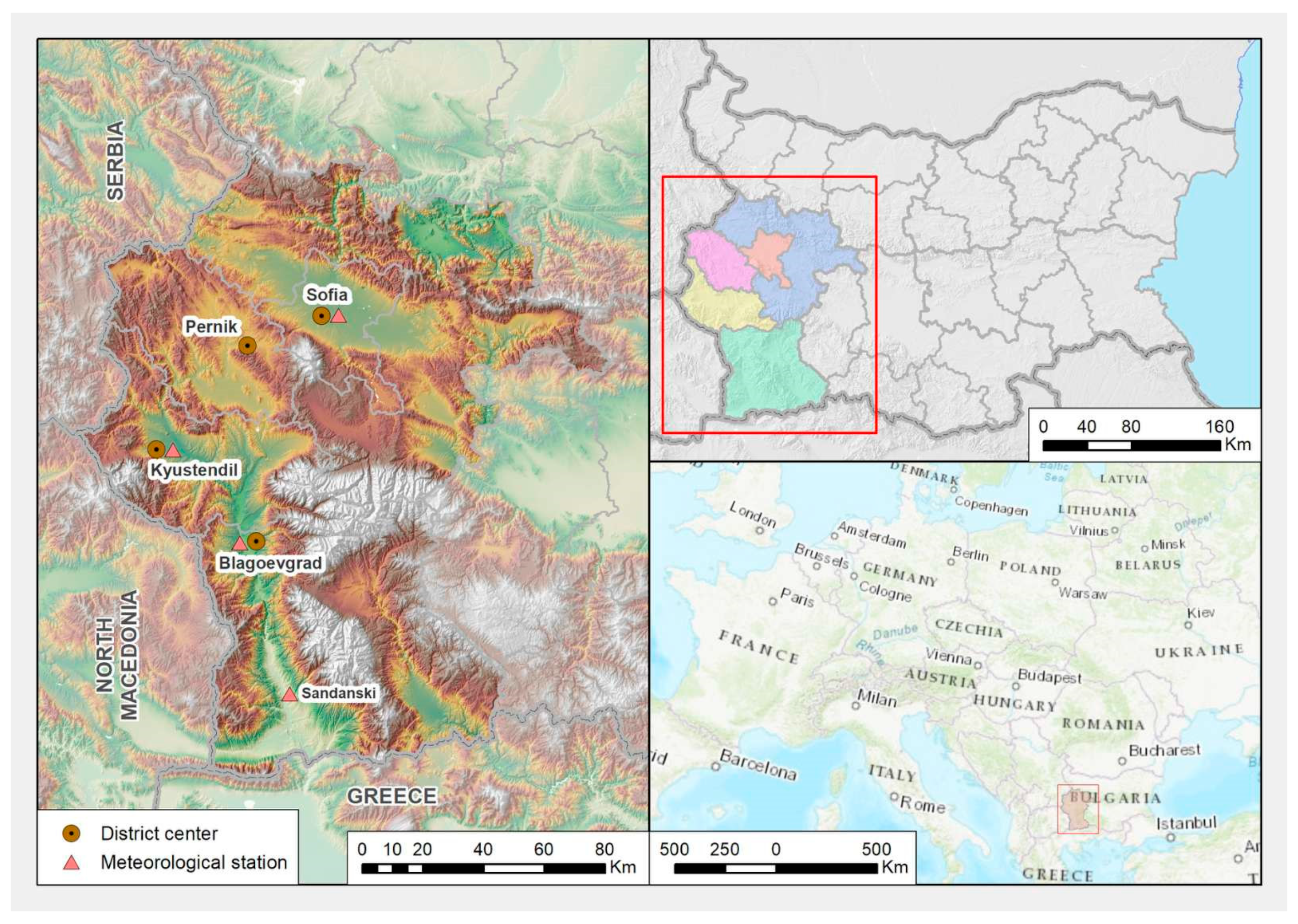

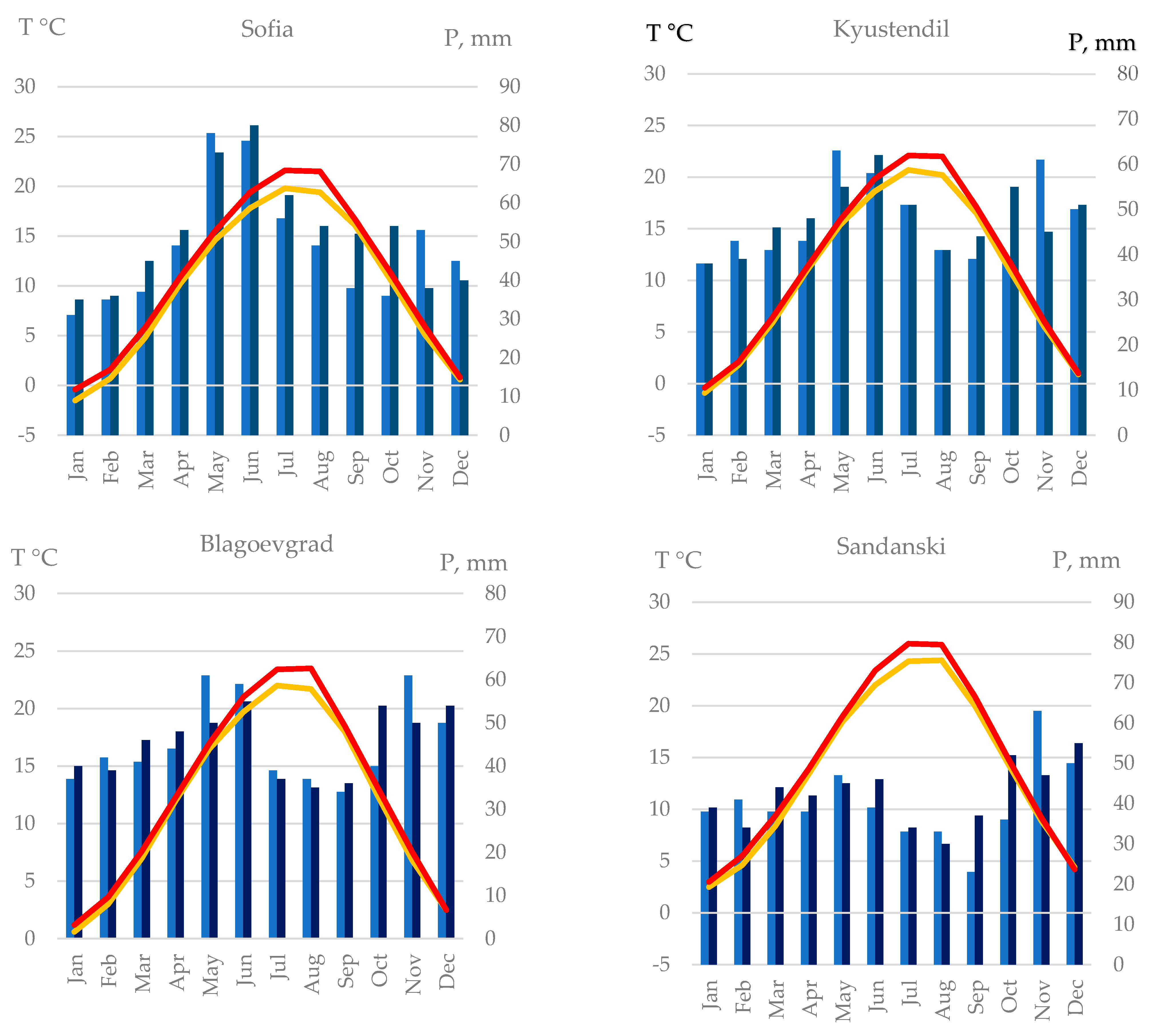
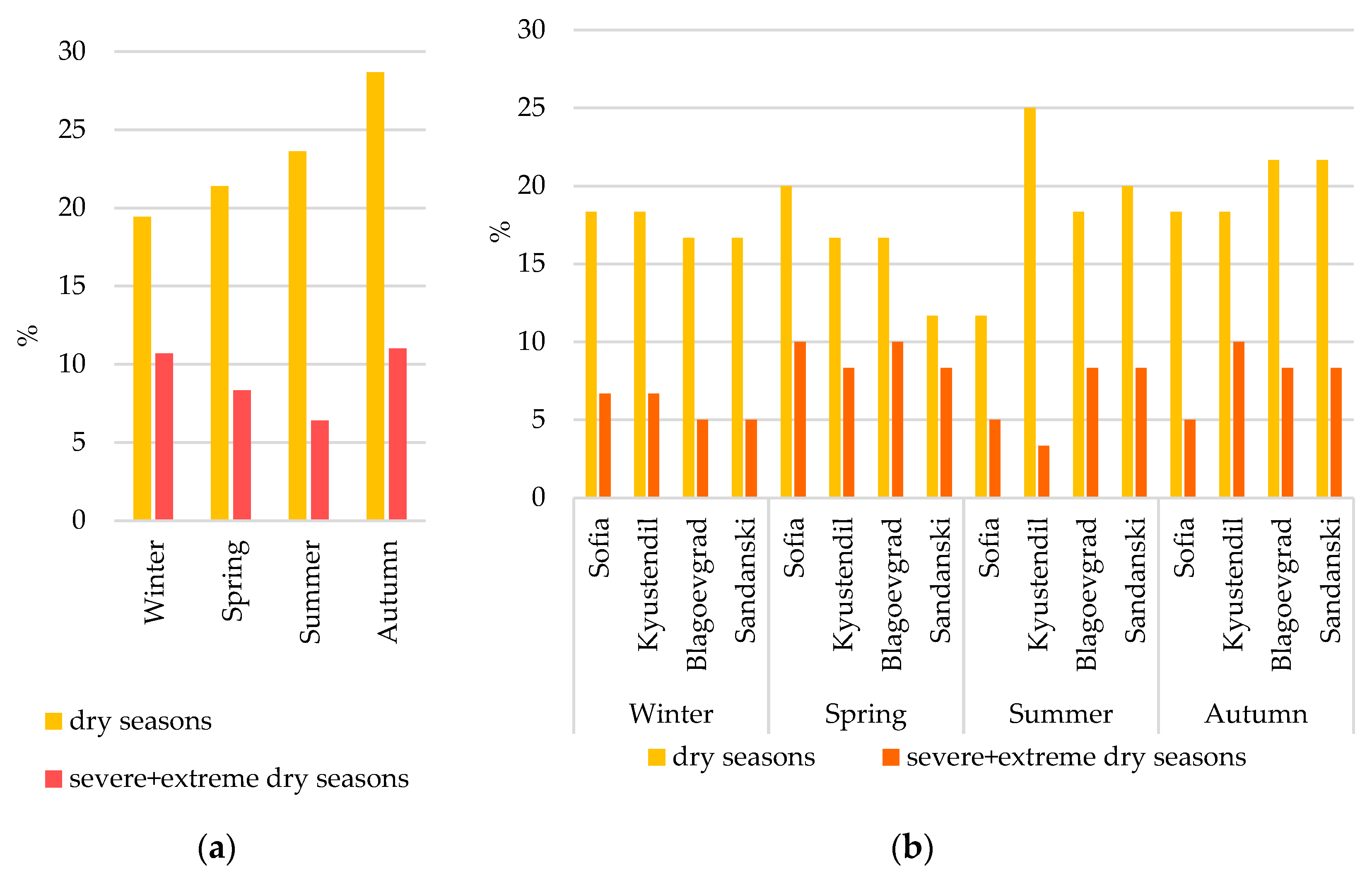
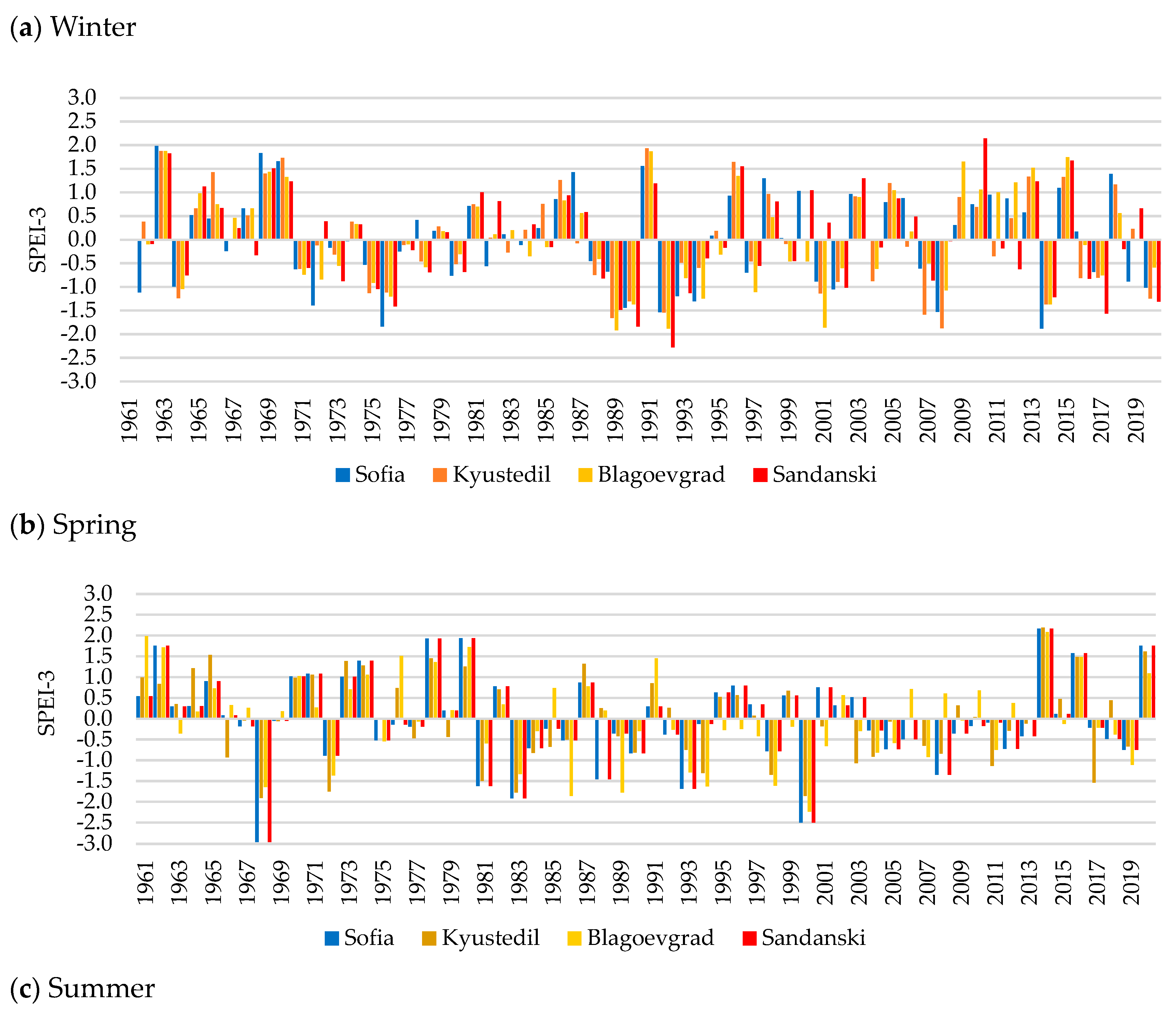

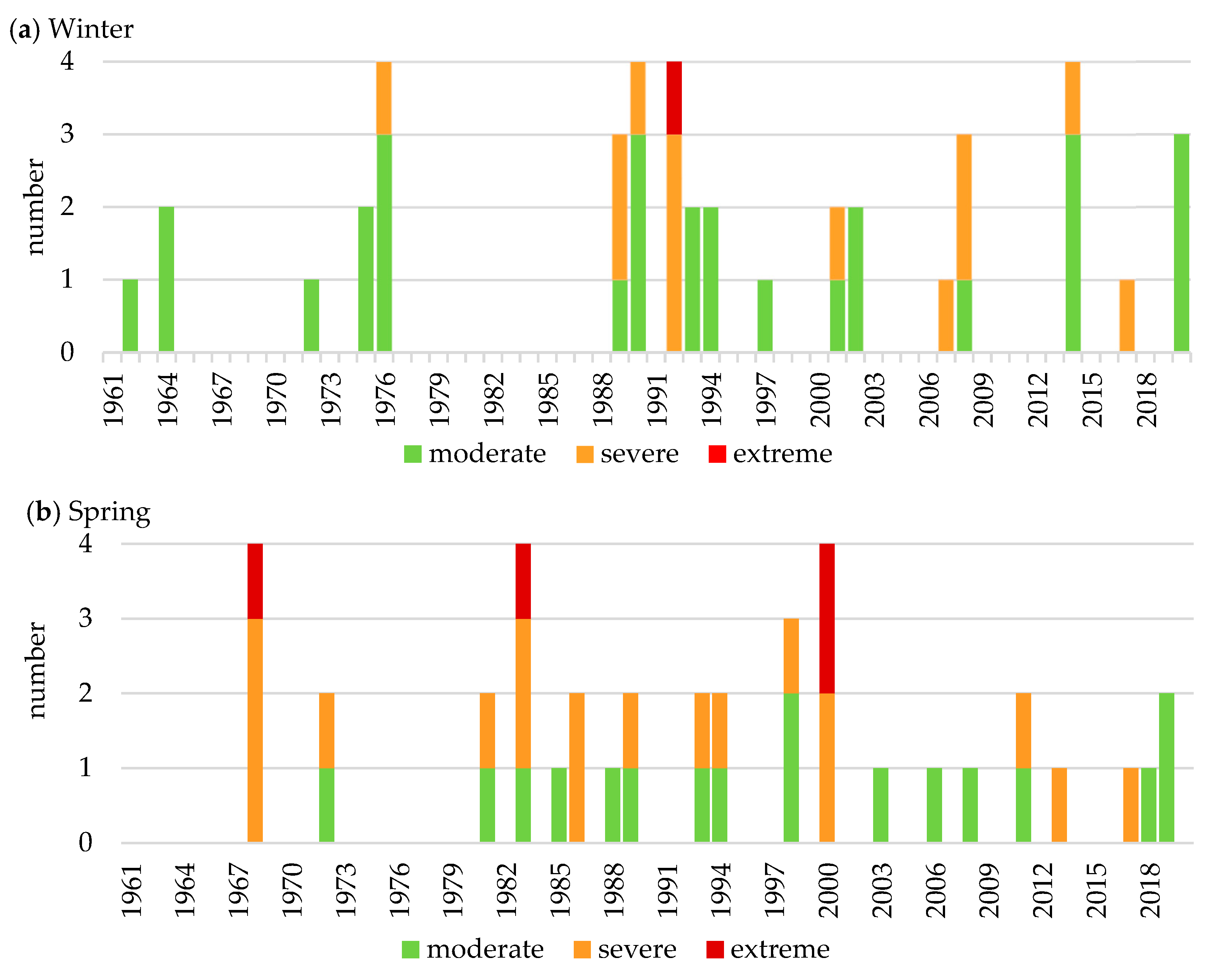
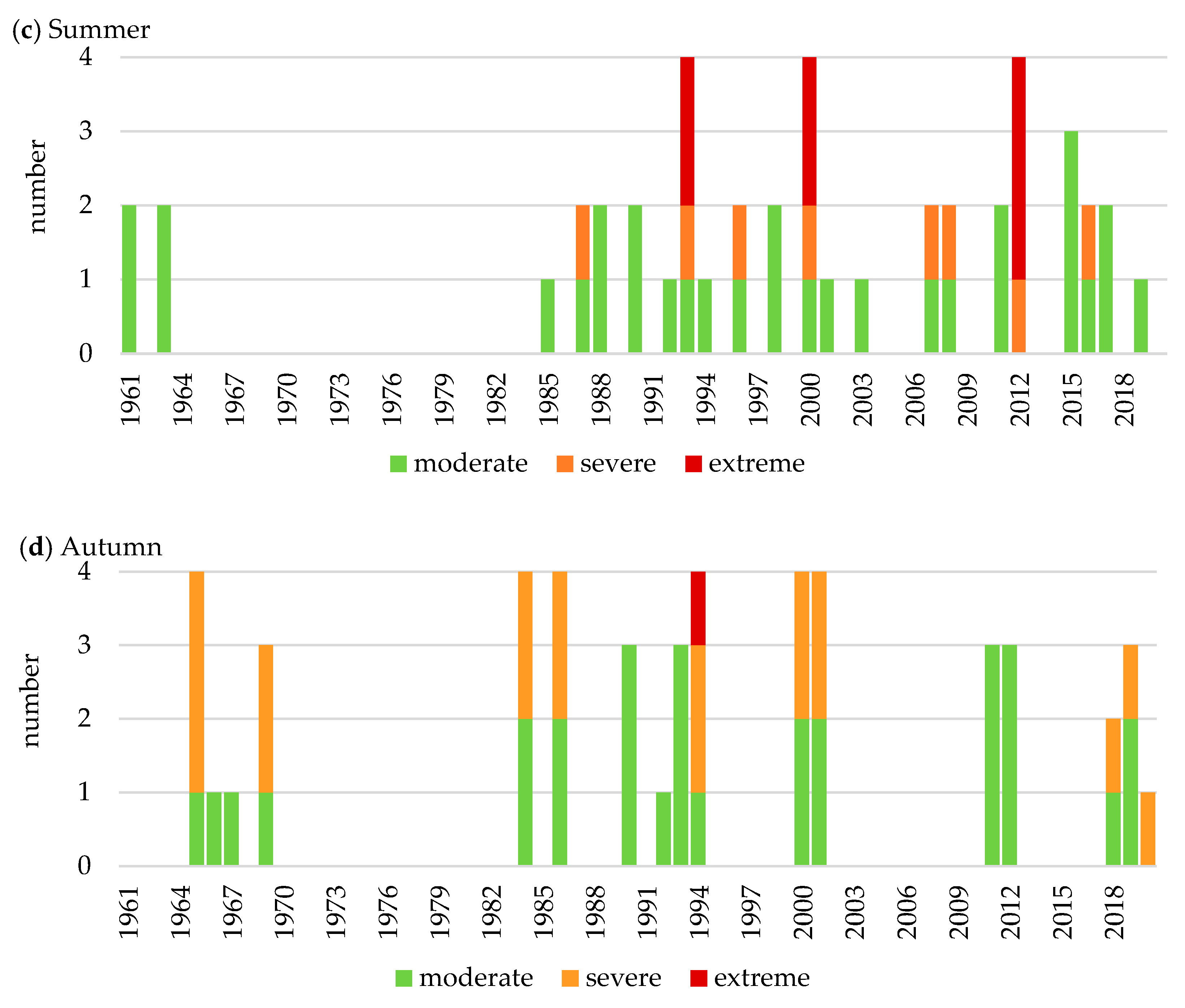

| Stations | Altitude (m a.s.l.) | Latitude (N) | Longitude (E) | Climate Zone |
|---|---|---|---|---|
| Sofia | 586 | 42°39′ | 23°23′ | Cfb |
| Kyustendil | 520 | 42°16′ | 22°43′ | Cfb |
| Blagoevgrad | 424 | 42°00′ | 23°05′ | Cfa |
| Sandanski | 206 | 41°33′ | 23°16′ | Csa |
| Pixel Centroid Coordinates | SPEI-3 | SPEI-6 | SPEI-12 | |
|---|---|---|---|---|
| Sofia | 42°45′ N; 23°15′ E | 0.81 | 0.84 | 0.86 |
| Kyustendil | 42°15′ N; 22°46′ E | 0.79 | 0.78 | 0.78 |
| Blagoevgrad | 42°15′ N; 23°15′ E | 0.72 | 0.72 | 0.71 |
| Sandanski | 41°45′ N; 23°15′ E | 0.70 | 0.68 | 0.65 |
| SPEI | Drought Category | |
|---|---|---|
| 2.3 | SPEI < −2.0 | extremely dry |
| 4.4 | −2.0 < SPEI < −1.5 | severely dry |
| 9.2 | −1.5 < SPEI < −1.0 | moderately dry |
| 68.2 | −1 < SPEI < 1.0 | near normal |
| 9.2 | 1.0 < SPEI < 1.5 | moderately wet |
| 4.4 | 1.5 < SPEI < 2.0 | very wet |
| 2.3 | 2.0 < SPEI | extremely wet |
| Meteorological Station | Maximum Duration/Months/ | Start | End | Lowest SPEI Values | DM | ADI |
|---|---|---|---|---|---|---|
| SPEI-3 | ||||||
| Sofia | 22 | Aug 1992 | May 1994 | −2.09 | 21.22 | −0.96 |
| Kyustendil | 28 | Oct 1992 | Jan 1995 | −1.93 | 25.26 | −0.90 |
| Blagoevgrad | 34 | Sep 1992 | Jun 1995 | −2.27 | 42.12 | −1.24 |
| Sandanski | 18 | Jul 1992 | Dec 1993 | −2.35 | 24.92 | −1.38 |
| SPEI-6 | ||||||
| Sofia | 32 | Sep 1992 | Apr 1995 | −2.07 | 37.65 | −1.18 |
| Kyustendil | 29 | Dec 1992 | Apr 1995 | −1.94 | 34.11 | −1.18 |
| Blagoevgrad | 41 | Mar 1999 | Jul 2002 | −2.79 | 49.78 | −1.21 |
| Sandanski | 47 | Jun 1991 | Apr 1995 | −2.75 | 59.60 | −1.27 |
| SPEI-12 | ||||||
| Sofia | 46 | Dec 1998 | Sep 2002 | −3.58 | 56.80 | −1.23 |
| Kyustendil | 33 | Feb 2011 | Oct 2013 | −2.05 | 37.09 | −1.12 |
| Blagoevgrad | 75 | Jun 1996 | Aug 2002 | −2.89 | 93.73 | −1.23 |
| Sandanski | 45 | Dec 1991 | Aug 1995 | −2.49 | 29.48 | −0.66 |
| NUTS 3 | Drought Hazard | |||||
|---|---|---|---|---|---|---|
| Very Low | Low | Moderate | High | Very High | ||
| Sofia city | SPEI-3 | 96 | 4 | |||
| SPEI-6 | 74 | 26 | ||||
| SPEI-12 | 30 | 69 | 1 | |||
| Sofia | SPEI-3 | 55 | 39 | 6 | ||
| SPEI-6 | 66 | 33 | 1 | |||
| SPEI-12 | 58 | 35 | 7 | |||
| Pernik | SPEI-3 | 2 | 33 | 65 | ||
| SPEI-6 | 15 | 85 | ||||
| SPEI-12 | 6 | 94 | ||||
| Kyustendil | SPEI-3 | 14 | 42 | 44 | ||
| SPEI-6 | 4 | 50 | 42 | 4 | ||
| SPEI-12 | 19 | 37 | 44 | |||
| Blagoevgrad | SPEI-3 | 4 | 22 | 21 | 35 | 19 |
| SPEI-6 | 1 | 43 | 40 | 15 | ||
| SPEI12 | 27 | 23 | 35 | 15 | ||
Disclaimer/Publisher’s Note: The statements, opinions and data contained in all publications are solely those of the individual author(s) and contributor(s) and not of MDPI and/or the editor(s). MDPI and/or the editor(s) disclaim responsibility for any injury to people or property resulting from any ideas, methods, instructions or products referred to in the content. |
© 2024 by the authors. Licensee MDPI, Basel, Switzerland. This article is an open access article distributed under the terms and conditions of the Creative Commons Attribution (CC BY) license (https://creativecommons.org/licenses/by/4.0/).
Share and Cite
Nikolova, N.; Radeva, K.; Todorov, L.; Matev, S. Drought Dynamics and Drought Hazard Assessment in Southwest Bulgaria. Atmosphere 2024, 15, 888. https://doi.org/10.3390/atmos15080888
Nikolova N, Radeva K, Todorov L, Matev S. Drought Dynamics and Drought Hazard Assessment in Southwest Bulgaria. Atmosphere. 2024; 15(8):888. https://doi.org/10.3390/atmos15080888
Chicago/Turabian StyleNikolova, Nina, Kalina Radeva, Leonid Todorov, and Simeon Matev. 2024. "Drought Dynamics and Drought Hazard Assessment in Southwest Bulgaria" Atmosphere 15, no. 8: 888. https://doi.org/10.3390/atmos15080888





